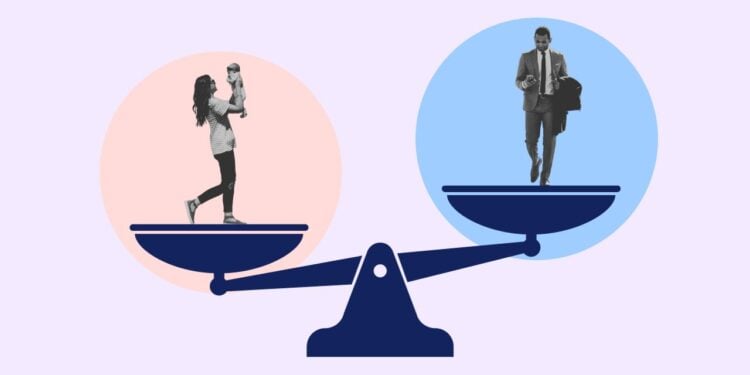- In 2023, working women still confront barriers to progression in the workplace, and many will experience lower pay compared to their male counterparts.
- There are additional systemic disadvantages once they become mothers. According to recent reports, it has been suggested that the motherhood penalty is responsible for 80% of the gender pay gap.
- Redesigning policies around parental leave could address gender imbalances in the workplace and positively influence societal attitudes towards unpaid childcare.
A year ago, Allwork.Space highlighted a Payscale report on the gender pay gap — and what it meant for working women. The report revealed that women with children in the U.S. earned $0.77 for each dollar earned by their male counterparts and that women with children were six times less likely to be hired than their male counterparts.
Although some positive efforts have been made to increase awareness and advance the argument for reducing gender inequality, the pay gap prevails (and in some cases has even widened). Plus, the childcare situation is becoming even more of a crisis. What does this mean for the future of working women? If far-reaching policy changes are not implemented, working women with children will continue to be penalized.
The motherhood penalty is the biggest threat to workplace gender parity
The gender pay gap is the difference in average earnings between women and men in the labor market. There are numerous reasons why the pay gap exists, ranging from occupational segregation (women are more likely to work in lower-paying occupations), a lack of representation in leadership roles, the insidious phenomenon known as the motherhood penalty, and continued pay discrimination (despite equal pay laws).
Many working women confront barriers to their progression in the workplace, but (as highlighted in a recent LinkedIn article), there are additional systemic disadvantages that women face at work once they become mothers. The motherhood penalty is a term used to describe the significant difference in pay and substantial loss in earnings between women who return to work after taking time out to focus on childcare relative to women who do not have children.
Although maternity is a protected characteristic, the constant threat of being subject to the motherhood penalty still looms large for working women. This penalty comprises 80% of the gender pay gap. It is no coincidence that the pay gap increases when women reach their thirties — a time when many women leave the workforce to have children.
Studies have shown that women with children earn less than women without children, even after controlling for factors such as education and experience. The penalty is more pronounced for women in high-paying jobs and those who take extended leaves of absence from work. The high cost of childcare, inadequate paternity leave policies, and flawed perceptions about the role of women perpetuate the penalization of women who wish to work and have children.
What keeps this disparity in check?
According to the most recent Price Waterhouse Coopers (PwC) report on women in work, it could take at least fifty years for Organization for Economic Cooperation and Development (OECD) nations to achieve gender pay parity. This is a disheartening statistic for women in these 37 countries (and beyond).
The latest PwC Women in Work Index indicates that there has been minimal progress towards workplace gender equality in OECD nations, with a gender pay gap reduction of only 2.5 percentage points since 2011. This Index is significant because it measures all key metrics relating to women’s employment outcomes.
The report on women in work and the LinkedIn article both highlight some of the reasons why the gender pay gap and the motherhood penalty persist, including the following:
- Gender-based discrimination (often at an institutional level)
- Long-held stereotypical expectations that women should do the lion’s share of unpaid labor (household management, childcare, and so on)
- A lower wage starting point for women and occupational segregation (women still dominate those sectors where pay is lower)
- Inadequate maternity leave arrangements in some countries and poor paternity leave in many countries
- The Covid pandemic (it has been reported that the pandemic exacerbated the amount of unpaid labor women do)
- The Maternal Wall — When women return to the workplace after becoming mothers they can find their competency brought into question (based on the fallacious notion that motherhood somehow reduces a woman’s ability to make “tough” decisions at work).
- The Glass Ceiling: This still exists for women in the workplace. There is an even lower ceiling for women who are members of disadvantaged minority communities and also mothers. For these women, an ethnic pay gap coexists with a gender pay gap.
In addition to these barriers to gender pay parity, some specific stereotypical notions keep the motherhood penalty in check — including the generalized view that a woman should sacrifice her career to support her male partner when a child arrives (despite more women assuming the role of breadwinner). Consequently, married men are more likely than their single counterparts to be in the top 1% of earners in the U.S. (a phenomenon often referred to as the Fatherhood Bonus).
There has been a widespread lack of improvement
According to the PwC Women in Work Index, the top three OECD nations in terms of employment outcomes for women are Luxembourg, Slovenia, and New Zealand. Scandinavian countries are consistently high-ranking, and Sweden often tops the list of countries where women thrive in the workplace. Germany (although only in 21st place) is an example of a country where some progress is occurring due to improved childcare provision. Since 2013, children over twelve months old have been entitled to a place in daycare at a subsidized (state) rate. This offer has made it more economically viable for women to return to work after having children.
Comparatively, in Australia (although ranked higher than Germany (16th) due to its smaller gender pay gap — 14.2% compared to 19.5%), unaffordable childcare is cited as the main barrier to working mothers engaging full-time in the labor market. Many Australian women have to choose between working only two or three days a week, as it is not financially viable for them to work full-time.
In the U.K. and Australia, companies must publicize their gender pay gap. This compulsory requirement has put slightly more pressure on employers, yet the absence of any legal requirement to reduce the pay gap means that many companies remain inactive on this issue. There are organizations in both countries that are raising awareness of the issue, and, on social media platforms such as X (formerly known as Twitter), there is a Gender Pay Gap Bot that serves to discredit companies that advocate on behalf of gender equality despite their own gender pay gap.
The PwC Women in Work Index reveals that the U.K. has fallen five places since 2014 (it currently occupies 14th place in the OECD’s rankings). This is due to the U.K.’s widening gender pay gap (from 11.9% in 2017/18 to 12.2% last year) and a fall in the participation rate of women in the workplace. In some sectors — such as education, construction, and finance — the gender pay gap is above 22%. Yet despite the higher pay gap, the U.K. still ranks highest among the G7 nations.
In the U.K., there is a correlation between decreasing rates of female participation in the labor market, extortionate childcare costs and a lack of engagement in the shared parental leave system (only 2-8% of eligible families participated in 2019). The U.K. has the most expensive childcare of any industrialized nation, depleting around 75% of parents’ incomes. Consequently, many women under the age of thirty have decided not to have children, whilst others are delaying the process (by freezing their eggs, for example). This is a concerning trend given Europe’s aging population and declining birth rate.
The U.S. comes in at 25th place in the OECD rankings (for a “neighborly” comparison, Canada ranks 18th). On the surface, the U.S. has made some progress in that women’s participation in the labor market has returned to pre-pandemic levels. However, this progress has been enjoyed only by women with children of school age rather than mothers of under-fives.
What needs to happen to improve outcomes for working women?
The U.K. government recently announced the provision of free childcare for children under the age of three. In theory, this policy should enable many mothers to return to work, but this could be challenging to implement. The childcare sector in the U.K. is already under pressure (due to a lack of funding) and might not cope with the demands of this new policy. Unaffordable childcare is one of the main obstacles to women returning to work, but so is the lack of availability of quality childcare; the two issues must be addressed simultaneously.
The availability of childcare is also at crisis levels in the U.S. Many parents in the workforce are staring down a bleak reality this month as their child care might vanish as federal funding for more than 70,000 centers has ended. The centers are at risk of closing by the end of when the federal government’s stabilization funds are set to expire. The funds, amounting to nearly $24 billion, were provided to states to sustain child care services as part of the U.S. American Rescue Plan of 2021.
This expiration could impact 3.2 million children and result in a potential loss of $10.6 billion in revenue due to decreased worker productivity. Parents may have to reduce work hours or even leave their jobs entirely in the search for alternative child care solutions.
Closing the gender pay gap will require a concerted effort from influential individuals, employers, and policymakers to address the underlying causes of gender-based inequity in the labor market. However, policies alone are not necessarily the answer. The situation is complex and requires cooperation between all relevant agencies and stakeholders.
Simply decreasing female unemployment and increasing women’s participation in the labor market will not suffice. Parental leave must become more equitable, and companies must recognize the benefits of offering equal paid parental leave (reduced turnover costs, for example). Redesigning parental leave policies could also facilitate the development of more positive societal attitudes towards unpaid childcare over time.
Latest reports on working women indicate minimal progress toward workplace gender equality.


 Dr. Gleb Tsipursky – The Office Whisperer
Dr. Gleb Tsipursky – The Office Whisperer Nirit Cohen – WorkFutures
Nirit Cohen – WorkFutures Angela Howard – Culture Expert
Angela Howard – Culture Expert Drew Jones – Design & Innovation
Drew Jones – Design & Innovation Jonathan Price – CRE & Flex Expert
Jonathan Price – CRE & Flex Expert














